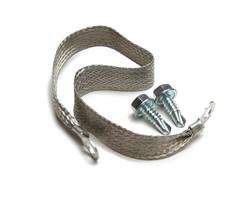My Egg Harbor was built with a bronze rectangular ground buss bar 1/4 thick by 3/4 wide by 15 feet?, running along the keel to which bonding wires are run from all metal fittings and fuel tanks. Bolts were drilled into the bar to attach on the wires. OEM used solid copper 10 gauge insulated wires. No wires were broken, all insulation still intact. All ring ends still ok. All ok even being from 1970. Solid bonding wires must have not been considered a problem in the old days. Frankly water has a harder time seeping along a smooth round wire than a multistranded wire inside of the insulation, less wicking. And even if it does get wet, being a solid wire with much greater size of the individual strand, so less corrosive possibility than with many strands wicking water. I really think such a wire is better as a bonding wire than a multistrand wire.
Nowhere can you step on them to damage them. Being a wood boat it has large frames- floors every 9 inches which have bonding wires running under these floors where they intersect to the keel, which in a house you would call joists.
I went through all of them when I rebuilt the hull in 2006. Some I need to take apart and clean as they are turned green the ones attaching to the shaft logs. Probably need to clean and grease with marine grease. Marine grease is water resistant, regular grease water slowly but steadily dissolves the grease. In the past, I noticed using regular greases, the grease eventually disappears and certainly does not prevent corrosion when salt water gets things wet..
Being wood hull, I disconnected all bonding wires to water through hulls as otherwise delignification has been a proven problem with wood boats. I left everything else connected.
When I rebuilt the hull, I moved the engine raw water thru-hulls to a new location, and the wood under there was a mess, but easily fixed with a steel brush, wood backing block, round wood plug, and polyurethane goo and screws.
 eek
eek bonding wire on my boat with tinned, stranded green marine cable. My plan is to use 10 AWG green wire from Genuine Dealz.
bonding wire on my boat with tinned, stranded green marine cable. My plan is to use 10 AWG green wire from Genuine Dealz.



